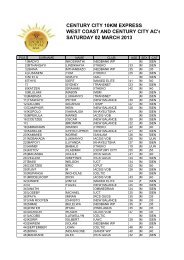Chapters 1 to 11 Combined - Century City
Chapters 1 to 11 Combined - Century City
Chapters 1 to 11 Combined - Century City
Create successful ePaper yourself
Turn your PDF publications into a flip-book with our unique Google optimized e-Paper software.
LIGHTING POLICYExterior lighting is required forvisibility and safety at night, butlighting must also help <strong>to</strong> promotethe vision of <strong>Century</strong> <strong>City</strong> as an areawhere people will live, work andplay. Apart from helping people findtheir way around at night, lightingcan identify major elements so thatpeople can recognize familiarfeatures of the daytime scene.However different levels and typesof lighting are appropriate atdifferent locations.Lighting within an urban context hasfour distinct functions:1. Illumination of roads. Theillumination of roads, junctionsand parking areas helps <strong>to</strong>ensure safer use by vehiclesand pedestrians. This lightingis usually pole mounted andnational standards existgoverning specifications.2. Security Lighting. Theillumination of open spaceshelps <strong>to</strong> enhance the personalsecurity of pedestrians,prevent dark corners andimprove visibility, and so detercrime. This lighting is usuallypole mounted.3. Signage Illumination. This isused <strong>to</strong> light up signage, roadnames and information <strong>to</strong>make these legible at night.This lighting usually consists ofbuilt–in light fittings or uplighters.4. Lighting effects. Lighting may beused in such a manner as <strong>to</strong>enhance the appearance andimpact of individual buildings orcivic spaces. Lighting may varyfrom up-lighting of mature trees,flood lighting of buildings,arrangements of street lights,fairy lights and decorative sensualpanels that come in many formsand colours.Along streets and major pedestriancorridors a good level of lighting isnecessary. On local roads and internalwalkways a more ambient form oflighting provides a softer moreattractive effect. Individual buildingsshould have door or post lamps <strong>to</strong>highlight entrances. Shrubs and treescan be lit up with good results. Lightscan convey a sense of warmth andactivity, but should not be <strong>to</strong>ooverpowering, and should not detractfrom the general amenity by being <strong>to</strong>odominant or compete with lights fromother buildings. Floodlighting of emptybuildings for “effect” should be avoidedbecause such lighting often emphasizesthe absence of people. Unless they aresymbolic landmarks, buildings shouldpreferably be lit from inside and outdoorlights should focus on where people aregathering or need <strong>to</strong> see.In general civic lighting can have abeneficial effect on the cityscape, itssafety and attractiveness. Care must betaken <strong>to</strong> avoid light pollution of thenight sky and address issues of energysustainability. Individual fittings shouldbe engineered so as not <strong>to</strong> spill lightunnecessarily by using pan <strong>to</strong>ps,louvres and shields. Low energycompact florescent bulbs help <strong>to</strong>increase energy efficiency in manycases.Lighting is a fundamental physicaland psychological part of city life andits use should be considered in termsof integrated design andperformance parameters according <strong>to</strong>different urban spaces. The patternof exterior lighting will have a majoreffect on the night landscape andmust be considered in the design ofbuildings and landscape areas.Information may be required <strong>to</strong>illustrate the impact of such lightingas part of the design review process.It must be recognized that darknessis a necessary contrast for the play oflight on the night time landscape andoverwhelming lighting effects candetract from the liveability of thearea.PLANNING PARTNERS: CENTURY CITY URBAN DESIGN FRAMEWORK Oc<strong>to</strong>ber 2005 50 REVISION 1





